1.高中英语语法通霸句子结构成分分析主语谓语宾语定语状语补语
精品-高中英语语法通霸2016-英语句子结构和成分分析
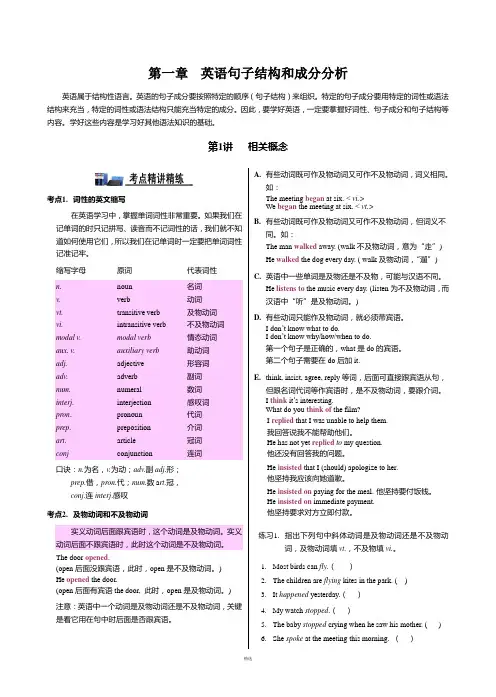
第一章英语句子结构和成分分析英语属于结构性语言。
英语的句子成分要按照特定的顺序(句子结构)来组织。
特定的句子成分要用特定的词性或语法结构来充当,特定的词性或语法结构只能充当特定的成分。
因此,要学好英语,一定要掌握好词性、句子成分和句子结构等内容。
学好这些内容是学习好其他语法知识的基础。
第1讲相关概念考点1.词性的英文缩写在英语学习中,掌握单词词性非常重要。
如果我们在记单词的时只记拼写、读音而不记词性的话,我们就不知道如何使用它们,所以我们在记单词时一定要把单词词性记准记牢。
缩写字母原词代表词性n. noun 名词v. verb 动词vt.transitive verb 及物动词vi.intransitive verb 不及物动词modal v. modal verb 情态动词aux. v. auxiliary verb 助动词adj.adjective 形容词adv.adverb 副词num. numeral 数词interj. interjection 感叹词pron. pronoun 代词prep.preposition 介词art. article 冠词conj conjunction 连词口诀:n.为名,v.为动;adv.副adj.形;prep.借,pron.代;num.数a rt.冠,conj.连interj.感叹考点2.及物动词和不及物动词实义动词后面跟宾语时,这个动词是及物动词。
实义动词后面不跟宾语时,此时这个动词是不及物动词。
The door opened.(open后面没跟宾语,此时,open是不及物动词。
)He opened the door.(open后面有宾语the door, 此时,open是及物动词。
)注意:英语中一个动词是及物动词还是不及物动词,关键是看它用在句中时后面是否跟宾语。
A.有些动词既可作及物动词又可作不及物动词,词义相同。
如:The meeting began at six. < vi.>We began the meeting at six. < vt.>B.有些动词既可作及物动词又可作不及物动词,但词义不同。
英语句子成分主语谓语宾语表语定语状语补语同位语讲解
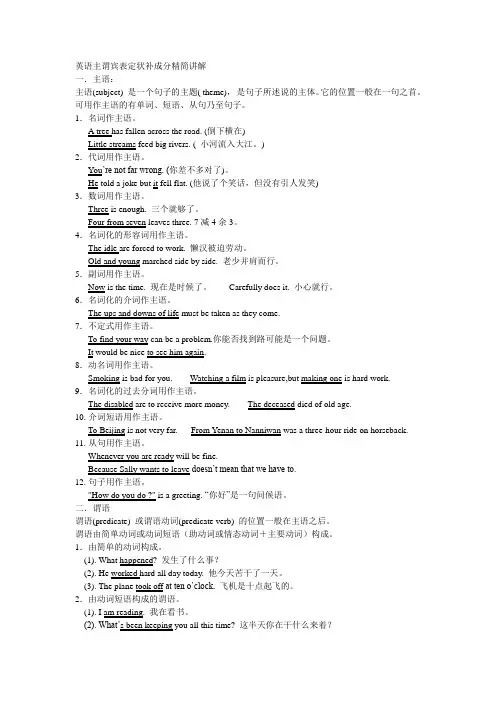
英语主谓宾表定状补成分精简讲解一.主语:主语(subject) 是一个句子的主题( theme),是句子所述说的主体。
它的位置一般在一句之首。
可用作主语的有单词、短语、从句乃至句子。
1.名词作主语。
A tree has fallen across the road. (倒下横在)Little streams feed big rivers. ( 小河流入大江。
)2.代词用作主语。
You’re not far wrong. (你差不多对了)。
He told a joke but it fell flat. (他说了个笑话,但没有引人发笑)3.数词用作主语。
Three is enough. 三个就够了。
Four from seven leaves three. 7减4余3。
4.名词化的形容词用作主语。
The idle are forced to work. 懒汉被迫劳动。
Old and young marched side by side. 老少并肩而行。
5.副词用作主语。
Now is the time. 现在是时候了。
Carefully does it. 小心就行。
6.名词化的介词作主语。
The ups and downs of life must be taken as they come.7.不定式用作主语。
To find your way can be a problem.你能否找到路可能是一个问题。
It would be nice to see him again.8.动名词用作主语。
Smoking is bad for you. Watching a film is pleasure,but making one is hard work.9.名词化的过去分词用作主语。
The disabled are to receive more money. The deceased died of old age.10.介词短语用作主语。
1.高中英语语法通霸句子结构成分分析主语谓语宾语定语状语补语
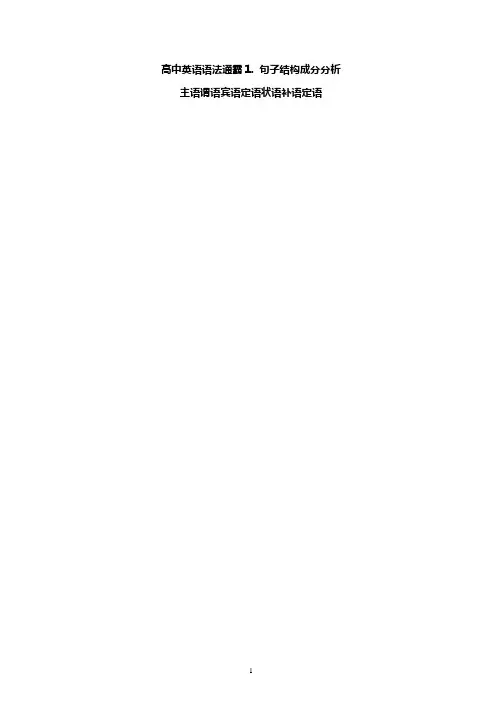
高中英语语法通霸1. 句子结构成分分析主语谓语宾语定语状语补语定语英语的句子成分主要有六种:即主语、谓语、宾语、定语、状语和补语。
(可以熟记为:主谓宾,定状补)除了这六种主要成分之外,还有“表语”和“同位语”的说法。
但表语和系动词一起作谓语,因此划分成分时,划分在谓语上.同位语分为主语同位语和宾语同位语,属于主语或宾语的一部分.考点1.划分句子成分时的常用符号英语中划分句子成分的符号主语在下面画直线谓语在下面画曲线宾语在下面画双横线定语在下面画虚线(一行点使我们想到一排钉子,“钉”谐音为“定语”的“定”)状语下面为短横线(短横线使我们想到短木桩,木桩撞(状)钟)补语上一短横,下一短横(下一短横好像是为了弥补上面短横间的空隙)同位语上下双曲线(都有曲折,上下位置基本相同)考点1.主语主语是一个句子所叙述的主体,一般位于句首,通常由名词性的词来充当.可以作主语的词性或语法结构:1. 名词2。
代词 3. 数词4。
不定式 5. 动名词 6. 主语从句等表示。
7。
名词化的形容词(如the rich)在英语中,形容词、副词和介词短语是不能作主语的。
如果它们在句首时,句子可能是倒装句,真正的主语在后面。
On the desk are some books。
(主语是books,所以用are)Down jumps the boy。
(主语是the boy,所以用jumps )Gone are the days. (主语是the days,所以用are)练习1.在下面句子的主语下面画横线,并说出由什么充当.1.During the 1990s, American country music has become more and more popular.2.We often speak English in class。
3.One-third of the students in this class are girls.4.To swim in the river is a great pleasure。
英语句子成分主语谓语宾语表语定语状语补语同位语讲解[整理版]
![英语句子成分主语谓语宾语表语定语状语补语同位语讲解[整理版]](https://uimg.taocdn.com/ba830d5ba6c30c2259019efe.webp)
英语句子成分主语谓语宾语表语定语状语补语同位语讲解[整理版]主语从句即一个句子作主语如:what he said is true. what he said是一个句子具备最短的句子所应有的主语(he)和谓语动词(said)。
又应有what引导词所以做从句,又Is 是大句子中的谓语动词,在主句中,所以其前的成分为主语,主语是一个句子,叫做主语从句。
宾语从句和主语从句同理,事不过宾语从句是在谓语动词后的句子,谓语后的成分是宾语。
如: He said that the girl is beautiful. that the girl is beautiful为宾语从句,做动词said后的宾语。
表语从句依然如此,只是动词为系动词或感官动词,动词后为表语从句。
如:He is who I am looking for. who I am looking for. 为表语从句,做系动词is的表语。
前几种句子均为名词性从句,引导词指人用who whose whom,指物用which,what。
其中which有范围 what没范围。
连接副词有:when where why how四种。
如:I don't know where he is going.(宾从)定语从句为形容词性从句,即一个句子像一个形容词,修饰一个名词或代词,而被修饰的词在句子前面,叫做先行词。
如:The girl who wears a red coat is my classmate. 其中who wears a red coat 是定语从句,修饰the girl, 所以the girl为先行词,主句为The girl is my classmate。
定语从句引导词指人和名词性从句相同,who whose whom;指物只用which,没有what;that 即指人又指物。
关系副词没有how 即 when,where,why.如: The year when I arrived there is 2000. (when I arrived there为从句)状语从句考点比较简单,记住他引导词的意思就行了,如时间是when while 等,地点是where wherever,原因是why 结果because等就可以了英语主谓宾表定状补成分精简讲解一(主语:主语(subject) 是一个句子的主题( theme),是句子所述说的主体。
专题二 高中英语语法句子结构成分分析报告主语谓语宾语定语状语补语
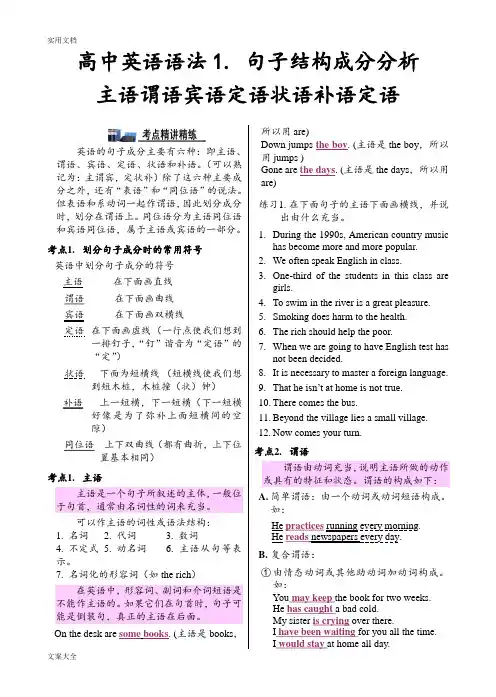
高中英语语法1. 句子结构成分分析主语谓语宾语定语状语补语定语英语的句子成分主要有六种:即主语、谓语、宾语、定语、状语和补语。
(可以熟记为:主谓宾,定状补)除了这六种主要成分之外,还有“表语”和“同位语”的说法。
但表语和系动词一起作谓语,因此划分成分时,划分在谓语上。
同位语分为主语同位语和宾语同位语,属于主语或宾语的一部分。
考点1.划分句子成分时的常用符号英语中划分句子成分的符号主语在下面画直线谓语在下面画曲线宾语在下面画双横线定语在下面画虚线(一行点使我们想到一排钉子,“钉”谐音为“定语”的“定”)状语下面为短横线(短横线使我们想到短木桩,木桩撞(状)钟)补语上一短横,下一短横(下一短横好像是为了弥补上面短横间的空隙)同位语上下双曲线(都有曲折,上下位置基本相同)考点1.主语主语是一个句子所叙述的主体,一般位于句首,通常由名词性的词来充当。
可以作主语的词性或语法结构:1. 名词2. 代词3. 数词4. 不定式5. 动名词6. 主语从句等表示。
7. 名词化的形容词(如the rich)在英语中,形容词、副词和介词短语是不能作主语的。
如果它们在句首时,句子可能是倒装句,真正的主语在后面。
On the desk are some books. (主语是books,所以用are)Down jumps the boy. (主语是the boy,所以用jumps )Gone are the days. (主语是the days,所以用are)练习1.在下面句子的主语下面画横线,并说出由什么充当。
1.During the 1990s, American country musichas become more and more popular.2.We often speak English in class.3.One-third of the students in this class aregirls.4.To swim in the river is a great pleasure.5.Smoking does harm to the health.6.The rich should help the poor.7.When we are going to have English test hasnot been decided.8.It is necessary to master a foreign language.9.That he isn’t at home is not true.10.There comes the bus.11.Beyond the village lies a small village.12.Now comes your turn.考点2.谓语谓语由动词充当,说明主语所做的动作或具有的特征和状态。
英语句子成分主语谓语宾语表语定语状语补语同位语讲解
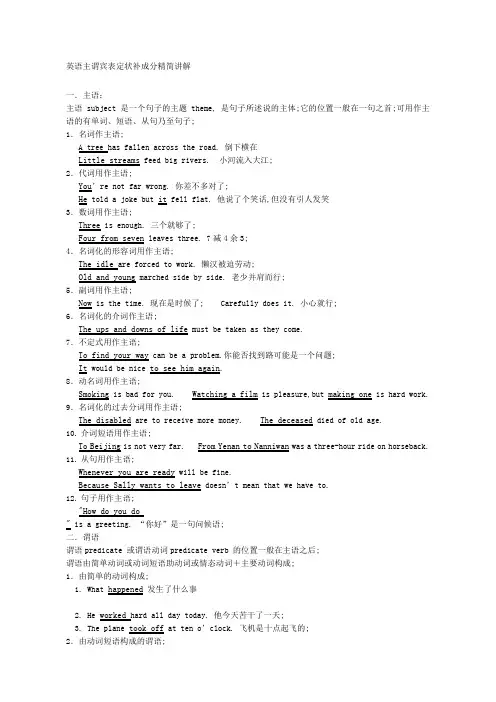
英语主谓宾表定状补成分精简讲解一.主语:主语subject 是一个句子的主题 theme, 是句子所述说的主体;它的位置一般在一句之首;可用作主语的有单词、短语、从句乃至句子;1.名词作主语;A tree has fallen across the road. 倒下横在Little streams feed big rivers. 小河流入大江;2.代词用作主语;You’re not far wrong. 你差不多对了;He told a joke but it fell flat. 他说了个笑话,但没有引人发笑3.数词用作主语;Three is enough. 三个就够了;Four from seven leaves three. 7减4余3;4.名词化的形容词用作主语;The idle are forced to work. 懒汉被迫劳动;Old and young marched side by side. 老少并肩而行;5.副词用作主语;Now is the time. 现在是时候了; Carefully does it. 小心就行;6.名词化的介词作主语;The ups and downs of life must be taken as they come.7.不定式用作主语;To find your way can be a problem.你能否找到路可能是一个问题;It would be nice to see him again.8.动名词用作主语;Smoking is bad for you. Watching a film is pleasure,but making one is hard work. 9.名词化的过去分词用作主语;The disabled are to receive more money. The deceased died of old age.10.介词短语用作主语;To Beijing is not very far. From Yenan to Nanniwan was a three-hour ride on horseback.11.从句用作主语;Whenever you are ready will be fine.Because Sally wants to leave doesn’t mean that we have to.12.句子用作主语;"How do you do" is a greeting. “你好”是一句问候语;二.谓语谓语predicate 或谓语动词predicate verb 的位置一般在主语之后;谓语由简单动词或动词短语助动词或情态动词+主要动词构成;1.由简单的动词构成;1. What happened发生了什么事2. He worked hard all day today. 他今天苦干了一天;3. The plane took off at ten o’clock. 飞机是十点起飞的;2.由动词短语构成的谓语;1. I am reading. 我在看书;2. What’s been keeping you all this time 这半天你在干什么来着3. You can do it if you try hard. 你努力就可以做到;3.英语常用某些动作名词代替表动态的谓语动词,表生动;这种动作名词之前常用没有多大意义的动词have, get, take, give 等;如:1. I had a swim yesterday. 我昨天游了一次水2. Take a look at that 你看看那个3. He gave a sigh. 他叹了口气;4. I got a good shake-up.我受到了很大的震动;三.表语表语的功能是表述主语的特征、状态、身份等;它也可以说是一种主语补语;它位于联系动词之后,与之构成所谓的系表结构;在系表结构中,联系动词只是形式上的谓语,真正起谓语作用的则是表语;可以作表语的词有:名词、代词、数词、形容词、副词、不定式、动名词、分词、介词短语、从句等;1.The wedding was that Sunday. 婚礼是在那个星期天举行的;名词2.So that’s that. 就是这样;代词3.We are seven. 我们一共7人;数词4.Are you busy你有空吗形容词5.Are you there 你在听吗电话用语副词Is anybody in里面有人吗副词6.All I could do was to wait.我只能等待;不定式My answer to his threat威胁 was to hit him on the nose. 不定式7plimenting赞美,祝贺 is lying. 恭维就是说谎;动名词Is that asking so much这是要的高了吗动名词8.I was so much surprised at it. 我对此事感到很惊讶;过分I’m very pleased with what he has done. 我对他所做的很满意;过分9.She is in good health. 她很健康;介词短语The show is from seven till ten. 演出时间为7点至10点;介词短语10.Is that why you were angry这就是你发怒的原因吗从句11.This is where I first met her.这就是我初次与她会面的地方;从句补充:能做系动词的实义动词:come , go , run, turn ,get , become , keep , stay , make 表变化的动词fell,sound ,smell , look , taste 感观动词 seem, appear 似乎,好像1.Our dream has come true. 我的梦想实现了;Come后常加 easy ,loose natural 等2. He fell sick. 他病了;Keep fit.保重;keep作为系动词还常接quiet ,calm ,cool, well, warm ,silent,clean,dry3.The well ran dry.这口井干枯了;short , loose , wild , cold 等4.A thin person always seems to be taller than he really is.四.宾语宾语object在句中主要充当动作的承受者,因此一般皆置于及物动词之后;如:Our team beat all the others. 我们的球队打败了所有其他球队;可以用作宾语的有:名词、代词、数词、名词化的形容词、副词、不定式、动名词、名词化的分词、从句等;1.Do you fancy a drink你想喝一杯吗名词2.They won’t hurt us. 他们不会伤害我们;代词3.If you add 5 to 5, you get 10. 5加5等于10;数词;4.I shall do my possible. 我将尽力而为;名词化形容词5.He left there last week. 他上个星期离开了那里;副词6.Does she really mean to leave home她真的要离开家吗不定式7.He never did the unexpected想不到的,意外的. 名词化的分词8.Do you understand what I mean你明白我的意思吗从句扩展:双宾语问题宾语中有些动词需要两个同等的宾语,即直接宾语direct object与间接宾语indirect object;直接宾语一般指动作的承受者,间接宾语指动作所向的或所为的人和物多指人;具有这种双宾语的及物动词叫做与格动词dative verb;间接宾语一般须与直接宾语连用,通常放在直接宾语之前;常用的有:answer, bring, buy, do, find, get, give, hand, keep, leave, lend, make, offer, owe, pass, pay, play, promise, read, save, sell, send, show, sing, take 等;如:Give me a cup of tea, please. I bought him a birthday present.I have found him a place. 我给他找到了一个职位;双宾语可以由介词to或for表达:Please give it to him. Mother cooks breakfast for us every day.五.补语补语complement是一种补足主语和宾语的意义的句子成分;补足主语意义的句子成分叫做主语补语subject complement,补足宾语意义的句子成分叫做宾语补语object complement.1. 形容词用作主语补语是常置于主语之前,后有逗号;Tired and sleepy, I went to bed.有时可以置于主语之后,前后都有逗号,与非限定性定语相似;如:The man, cruel beyond belief, didn’t listen to their pleadings.2.可以用做宾语补语的有名词、形容词、不定式、动名词、分词、介词短语等named the child Jimmy. 他们将孩子命名为吉米;名词用作并与补语mother looks so young that you would think her my sister. 名词短语作宾语补语3. He boiled the egg hard. 她将鸡蛋煮老了;形容词用作宾语补语found the book very interesting.我发现那本书很有趣;形容词短语用作宾补comrades wanted Dr. Bethune to take cover. 不定式用作宾语补语call this robbing Peter to pay Paul.我把这个叫做拆东墙补西墙;动名作宾补’t take his kindness for granted.不要把他的友善看作是当然的事;六.定语定语是用来说明名词代词的品质与特征的词或一组词;可用作定语的有:形容词、名词、代词、数词、副词、不定式、动名词、分词、介词短语、从句和句子等;1.形容词用作定语是大量的;1. She is a natural musician.2. He must be the best violinist alive.后置定语2. 名词用作定语;1. A baby girl 女婴2. well water 井水3. Sports car 双座轻型汽车2.代词作定语;1. Your hair needs cutting. 物主代词用作定语2. Everybody’s business is nobody’s business. 不定代词所有格作定语3.数词作定语1. There’s only one way to do it. 做此事只有一法;2. Do it now, you may not get a second chance.基数词用作后置定语: page 24 , Room 201 , the year 19494. 副词充当定语时常后置,如:the room above楼上的房间 the world today今日世界the way out出路 a day off休息日5.不定式用作定语1. Her promise to write was forgotten.她忘记了答应写信的事;2. That’s the way to do it.那正是做此事的方法;6.动名词用作定语.A walking stick 拐杖sleeping pills 安眠药eating implements 吃饭用具learning method 学习方法7.分词充当定语a sleeping child 正在睡中的小孩 a drinking man 嗜酒者a retired worker 一个退休工人 a faded flower 一朵谢了的花7.介词短语用作定语;1. This is a map of China. 这是一幅中国地图;2. The wild look in his eyes spoke plainer than words.8.从句用作定语,即定语从句The car that’s parked outside is mine. 停在外面的车是我的;Your car, which I noticed outside, has been hit by another one.七.同位语当两个指同一事物的句子成分放在同等位置时,一个句子成分可被用来说明或解释另一个句子成分,前者就叫做后者的同位语appositive.这两个句子成分多由名词代词担任,同位语通常皆放在其说明的名词代词之后;1.名词用作同位语是大量的;1. We have two children, a boy and a girl.2.We, the Chinese people, are determined to build China into a powerful country.2.代词用作同位语;1.They all wanted to see him.2.Let’s you and me go to work, Oliver.3.数词用作同位语;1.Are you two ready2.They two went, we three stayed behind.4.不定式与动名词用作同位语;1.Their latest proposal, to concentrate on primary education, has met with some opposition.2.The first plan, attacking at night, was turned down.5.Of 短语用作同位语The city of Rome罗马城 the art of writing写作艺术 The vice of smoking吸烟嗜好6.从句用同位语,即同位语从句1.The news that we are having a holiday tomorrow is not true.2.We are not investigating the question whether he is trustworthy.八.状语状语adverbial是修饰动词、形容词、副词以及全句的句子成分;;如:1.The girl is improving remarkably. 这个女孩大有进步;2.作状语的有副词、名词、代词、数词、形容词、不定式、分词、介词短语、从句等;副词最常用作状语,位置比较灵活,可置句末、句首和句中;He speaks the language badly but read it well.Naturally we expect hotel guests to lock their doors.3.按用途分时间、地点、方式、原因、结果、目的、条件、让步、程度、方式、伴随等1;时间状语,多位于句末和句首,有时亦可置于句中Shall we do the shopping today or tomorrow Now China leads the world.2.地点状语,多置于句末,有时也位于句首和句中;There are plenty of fish in the sea. She kissed her mother on the platform月台.3.原因状语,包括表理由的状语,多置于句末,有时亦可置于句首;Because he was ill ,Tom lost his job. I eat potatoes because I like them.4. 结果状语,多由不定式、分词和从句表示,常位于句末;She woke醒 suddenly to find someone standing in the doorway.She spoke so softly that I couldn’t hear what she said.5. 目的状语,多由不定式、介词短语和从句等表示,常位于句末,强调时可以置于句首;He ran for shelter隐蔽处. In order to get into a good school, I must study even harder.6. 条件状语;多由短语和从句表示,常置于句末和句首;We’ll be lucky to get there before dark.If he were to come, what should we say to him7. 让步状语,由短语和从句表示,常置于句末和句首;For all his money, he didn’t seem happy. He helped me although he didn’t know me.8. 程度状语;常由副词、介词短语及从句等表示;The lecture is very interesting. To what extent would you trust them程度9.伴随状语,常由短语和独立主格等表示;对位于句末和句首;My train starts at six, arriving at Chicago at ten.He stood there pipe烟斗 in mouth.。
专题二 高中英语语法句子结构成分分析主语谓语宾语定语状语补语
高中英语语法1. 句子结构成分分析主语谓语宾语定语状语补语定语英语的句子成分主要有六种:即主语、谓语、宾语、定语、状语和补语。
(可以熟记为:主谓宾,定状补)除了这六种主要成分之外,还有“表语”和“同位语”的说法。
但表语和系动词一起作谓语,因此划分成分时,划分在谓语上。
同位语分为主语同位语和宾语同位语,属于主语或宾语的一部分。
考点1.划分句子成分时的常用符号英语中划分句子成分的符号主语在下面画直线谓语在下面画曲线宾语在下面画双横线定语在下面画虚线(一行点使我们想到一排钉子,“钉”谐音为“定语”的“定”)状语下面为短横线(短横线使我们想到短木桩,木桩撞(状)钟)补语上一短横,下一短横(下一短横好像是为了弥补上面短横间的空隙)同位语上下双曲线(都有曲折,上下位置基本相同)考点1.主语主语是一个句子所叙述的主体,一般位于句首,通常由名词性的词来充当。
可以作主语的词性或语法结构:1. 名词2. 代词3. 数词4. 不定式5. 动名词6. 主语从句等表示。
7. 名词化的形容词(如the rich)在英语中,形容词、副词和介词短语是不能作主语的。
如果它们在句首时,句子可能是倒装句,真正的主语在后面。
On the desk are some books. (主语是books,所以用are)Down jumps the boy. (主语是the boy,所以用jumps )Gone are the days. (主语是the days,所以用are)练习1.在下面句子的主语下面画横线,并说出由什么充当。
1.During the 1990s, American country musichas become more and more popular.2.We often speak English in class.3.One-third of the students in this class aregirls.4.To swim in the river is a great pleasure.5.Smoking does harm to the health.6.The rich should help the poor.7.When we are going to have English test hasnot been decided.8.It is necessary to master a foreign language.9.That he isn’t at home is not true.10.There comes the bus.11.Beyond the village lies a small village.12.Now comes your turn.考点2.谓语谓语由动词充当,说明主语所做的动作或具有的特征和状态。
精品-高中英语语法通霸2016-英语句子结构和成分分析
第一章英语句子结构和成分分析英语属于结构性语言.英语的句子成分要按照特定的顺序(句子结构)来组织。
特定的句子成分要用特定的词性或语法结构来充当,特定的词性或语法结构只能充当特定的成分.因此,要学好英语,一定要掌握好词性、句子成分和句子结构等内容。
学好这些内容是学习好其他语法知识的基础。
第1讲相关概念考点1.词性的英文缩写在英语学习中,掌握单词词性非常重要。
如果我们在记单词的时只记拼写、读音而不记词性的话,我们就不知道如何使用它们,所以我们在记单词时一定要把单词词性记准记牢。
缩写字母原词代表词性n。
noun 名词v. verb 动词vt。
transitive verb 及物动词vi。
intransitive verb 不及物动词modal v。
modal verb 情态动词aux。
v。
auxiliary verb 助动词adj.adjective 形容词adv。
adverb 副词num。
numeral 数词interj。
interjection 感叹词pron. pronoun 代词prep。
preposition 介词art。
article 冠词conj conjunction 连词口诀:n。
为名,v。
为动;adv。
副adj。
形;prep。
借,pron.代;num。
数a rt。
冠,conj.连interj。
感叹考点2.及物动词和不及物动词实义动词后面跟宾语时,这个动词是及物动词.实义动词后面不跟宾语时,此时这个动词是不及物动词。
The door opened.(open后面没跟宾语,此时,open是不及物动词.)He opened the door。
(open后面有宾语the door,此时,open是及物动词。
)注意:英语中一个动词是及物动词还是不及物动词,关键是看它用在句中时后面是否跟宾语。
A.有些动词既可作及物动词又可作不及物动词,词义相同。
如:The meeting began at six。
句子成分:主语、谓语、宾语、表语、定语、宾语补足语和状语 高考英语语法重点归纳
十一、句子成分:主语、谓语、宾语、表语、定语、宾语补足语和状语1、主语:(1)由名词、代词(人称代词用主格)、动词不定式、动名词等充当,说明动作是“谁”发出的,主语是句子陈述的对象,说明是谁或什么,表示句子说的是“什么人”,或”什么事“,如“我写字”中的“我”,做出写字这个动作。
“写”则是谓语,“字”是宾语,是接受谓语“写”这个动作的对象,因此是宾语。
如:The painter painted a very nice picture. (画家画了一幅漂亮的画。
) / They fought against SARS bravely. (他们勇敢地与非典搏斗。
) / To see is to believe. (耳听为虚眼见为实). / Helping animals is to help people. (帮助动物就是帮助人类。
)(2)动词不定式或动名词做主语时可用it代替,而不定式或动名词移至表语或宾语之后。
如:It is very comfortable to have a Class A seat during the long journey. (在长途旅行中能有个甲等座位简直太舒服了。
) / Eating too much is bad for your health.(=It is bad for your health eating too much.) (吃得太多对你的身体不利。
)(比较好看,避免头重脚轻)(3)口语中常见主语或“主--系”省略:(It is) nothing. ((那)没有什么。
)/ (It) doesn’t matter.((那)没有关系。
) / (I) thank you. ((我)谢谢你。
)(4)反意问句的附加问句,主语必须是代词:The man looks worried, doesn’t he? (这个人看上去很着急不是吗?) / Tigers are dangerous animals, aren’t they? (老虎是危险的动物不是吗?)(5)祈使句一般省略主语。
精品-高中英语语法通霸201英语句子结构和成分分析
英语句子结构和成分分析第一章英语属于结构性语言。
英语的句子成分要按照特定的顺序(句子结构)来组织。
特定的句子成分要用特定的词性或语法结构来充当,特定的词性或语法结构只能充当特定的成分。
因此,要学好英语,一定要掌握好词性、句子成分和句子结构等内容。
学好这些内容是学习好其他语法知识的基础。
相关概念讲第1有些动词既可作及物动词又可作不及物动词,词义相同。
A.如:at six. < vi.>The meeting began词性的英文缩写考点1. the meeting at six. < vt.>We began在英语学习中,掌握单词词性非常重要。
如果我们在有些动词既可作及物动词又可作不及物动词,但词义不B.记单词的时只记拼写、读音而不记词性的话,我们就不知同。
如:所以我们在记单词时一定要把单词词性道如何使用它们,) away. (walk不及物动词,意为“走”The man walked记准记牢。
) 及物动词,“遛”He walked the dog every day. ( walk 原词缩写字母代表词性英语中一些单词是及物还是不及物,可能与汉语不同。
C.n. 名词noun 而为不及物动词,listens to the music every day. (listenHeverb 动词v. )汉语中“听”是及物动词。
transitive verb 及物动词vt. D.有些动词只能作及物动词,就必须带宾语。
intransitive verb vi.不及物动词t know what to do.I don't know why/how/when to do.'I don情态动词modal v. modal verb的宾语。
第一个句子是正确的,what是do aux. v. 助动词auxiliary verbit.后加do第二个句子需要在adj.adjective 形容词adverb 副词adv.等词,后面可直接跟宾语从句,think, insist, agree, reply E.数词num.numeral但跟名词代词等作宾语时,是不及物动词,要跟介词。
- 1、下载文档前请自行甄别文档内容的完整性,平台不提供额外的编辑、内容补充、找答案等附加服务。
- 2、"仅部分预览"的文档,不可在线预览部分如存在完整性等问题,可反馈申请退款(可完整预览的文档不适用该条件!)。
- 3、如文档侵犯您的权益,请联系客服反馈,我们会尽快为您处理(人工客服工作时间:9:00-18:30)。
高中英语语法通霸1. 句子结构成分分析主语谓语宾语定语状语补语定语英语的句子成分主要有六种:即主语、谓语、宾语、定语、状语和补语。
(可以熟记为:主谓宾,定状补)除了这六种主要成分之外,还有“表语"和“同位语”的说法。
但表语和系动词一起作谓语,因此划分成分时,划分在谓语上。
同位语分为主语同位语和宾语同位语,属于主语或宾语的一部分.考点1.划分句子成分时的常用符号英语中划分句子成分的符号主语在下面画直线谓语在下面画曲线宾语在下面画双横线定语在下面画虚线 (一行点使我们想到一排钉子,“钉"谐音为“定语”的“定”)状语下面为短横线(短横线使我们想到短木桩,木桩撞(状)钟)补语上一短横,下一短横(下一短横好像是为了弥补上面短横间的空隙)同位语上下双曲线(都有曲折,上下位置基本相同)考点1.主语主语是一个句子所叙述的主体,一般位于句首,通常由名词性的词来充当。
可以作主语的词性或语法结构:1. 名词2。
代词3。
数词4。
不定式5。
动名词6。
主语从句等表示。
7。
名词化的形容词(如the rich)在英语中,形容词、副词和介词短语是不能作主语的。
如果它们在句首时,句子可能是倒装句,真正的主语在后面。
On the desk are some books。
(主语是books,所以用are)Down jumps the boy。
(主语是the boy,所以用jumps )Gone are the days. (主语是the days,所以用are)练习1.在下面句子的主语下面画横线,并说出由什么充当。
1.During the 1990s,American country music has become more and more popular.2.We often speak English in class.3.One—third of the students in this class are girls。
4.To swim in the river is a great pleasure。
5.Smoking does harm to the health。
6.The rich should help the poor.7.When we are going to have English test has not been decided。
8.It is necessary to master a foreign language.9.That he isn't at home is not true.10.There comes the bus。
11.Beyond the village lies a small village.12.Now comes your turn.考点2.谓语谓语由动词充当,说明主语所做的动作或具有的特征和状态.谓语的构成如下:A.简单谓语:由一个动词或动词短语构成。
如:He practices running every morningHe reads newspapers every day.B.复合谓语:①由情态动词或其他助动词加动词构成。
如:You may keep the book for two weeks.He has caught a bad cold.My sister is crying over there。
I have been waiting for you all the time。
I would stay at home all day。
Has he come back?He did n't attend the meeting yesterday。
②由系动词加表语构成。
系动词不能单独作谓语,要和表语一起作谓语。
如:We are student s。
Your idea sounds great.考点3.表语表语多是形容词,用以说明主语的身份、特征和状态,它一般位于系动词(如be,become, get, look,grow,turn,seem等)之后。
表语一般由名词、代词、形容词、分词、数词、不定式、动名词、介词短语、副词及表语从句表示.练习2.画出下列句中的表语,并说明由什么充当.1.Our teacher of English is an American。
2.Is it yours?3.The weather has turned cold.4.The speech is exciting。
5.Three times seven is twenty—one。
6.His job is to teach English.7.His hobby(爱好)is playing football。
8.The machine must be under repairs。
9.The truth is that he has never been abroad.考点4.宾语宾语由名词性的词充当,表示动作的对象或承受者,一般位于及物动词和介词后面。
宾语分为动词宾语和介词宾语.练习3.画出下列句中的宾语, 并说明由什么充当。
1.They planted many trees yesterday。
2.(How many dictionaries do you have?)I have five。
3.They helped the old with their housework yesterday。
4.I wanted to buy a car.5.I enjoy listening to popular music。
6.I think(that)he is fit for his office.考点5.宾语补足语宾语补足语和宾语构成逻辑上的主谓关系。
换句话说,在意思上,宾语相当于宾补的主语。
带有宾语补足语的一般句型为:某些及物动词(如make等)+宾语+宾补.宾补可由名词、形容词、副词、不定式、分词、介词短语和从句充当。
练习4.用下划线画出下列句中的宾语补足语,并指出是什么词充当,同时体会宾补和宾语之间的逻辑关系。
1.His father named him Dongming.2.They painted their boat white。
3.Let the fresh air in。
4.You mustn’t force him to lend his money to you.5.We saw her entering the room.6.We found everything in the lab in good order。
7.We will soon make our city what your city is now。
8.I want your homework done on time。
考点6.主补对主语的补充。
含有宾语补足语的句子在变成被动语态,宾语作主语时,原来的宾补就成了主语补足语。
He was elected monitor。
She was found singing in the next room.He was advised to teach the lazy boy a lesson。
考点7.定语定语是对名词或代词起修饰、限定作用的词、短语或句子,汉语中常用“……的"表示.定语通常位于被修饰的成分前。
在英语中,许多情况下,定语是放在所修饰词后面的,这点与汉语习惯不同,也是许多同学不能读懂长句的主要原因。
定语后置常见的有以下几种情况:A.副词用作定语一般要后置。
People there are very friendly。
(那儿的人们)He didn’t like the man downstairs. (楼下的那个人)B.形容词短语作定语一般放在所修饰词之后.单个形容词作定语一般放在所修饰词之前,而形容词短语作定语一般放在所修饰词之后.The next man is a scientist。
The man next to me is a scientist。
(我旁边的那个人)C.介词短语作定语时要后置。
The boy under the tree is Tom。
(树下的那个男孩)The tallest boy in our class is John。
(我们班最高的那个男孩)D.现在分词短语、过去分词短语、动词不定式作定语常后置.I have something to say. (直译:我有要说的话)The boy crying over there is my classmate。
(在那边哭的那个男孩)The house built last year is impressive。
(去年建的那座房子)练习5.口头翻译下列句子,用下划线标出定语部分,留意定语的位置,并说明定语是由什么词性或结构充当。
1.The letter on the desk is for Mr。
Wu。
2.The woman with a baby in her arms is his mother。
3.We need a place twice larger than this one。
4.She carried a basket full of eggs。
5.It’s a book worth no more than one dollar。
6.It's a city far from the coast.7.He has money enough to buy a car。
8.The man downstairs was trying to sleep。
9.There are lots of places of interest needing repairing in our city.10.Tigers belonging to meat—eating animals feed on meat.11. A boy calling himself John wanted to see you.12.He picked up a wallet lying on the ground on the way back home。
13.There are many clothes to be washed。
14.Most of the singers invited to the party were from America.15.Then the great day came when he was to march past the palace in the team。
